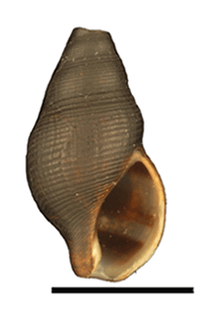Clea (gastropod)
Clea is a genus of freshwater snails with opercula, aquatic gastropod mollusks in the family Nassariidae, a family, almost all of the rest of which are marine.
| Clea | |
|---|---|
 | |
| Clea bockii shell | |
| Scientific classification | |
| Kingdom: | Animalia |
| Phylum: | Mollusca |
| Class: | Gastropoda |
| Clade: | Caenogastropoda |
| Clade: | Hypsogastropoda |
| Clade: | Neogastropoda |
| Family: | Nassariidae |
| Genus: | Clea A. Adams, 1855[1] |
| Type species | |
| Clea nigricans A. Adams, 1855 | |
| Synonyms[2] | |
|
Quadrasia Crosse, 1886 | |
Name
The members of this genus are known as assassin snails for their habit of eating other snails. They bury themselves and ambush their prey.
Taxonomy
This genus was treated within family Buccinidae. It was moved to family Nassariidae in 2016.[3] It was classified in the newly established subfamily Anentominae within Nassariidae in 2017.[4]
Species
Species within the genus Clea include:[2]
- Clea bangueyensis Smith, 1895
- Clea bockii Brot, 1881
- Clea funesta H. Adams, 1862
- Clea hidalgoi (Crosse, 1886)
- Clea nigricans A. Adams, 1855 - type species of the genus Clea
The following species are treated within the separate genus Anentome. Previously they were treated within the subgenus Anentome.[5]
- Clea bizonata (Deshayes, 1876) - synonym of Anentome bizonata (Deshayes, 1876)
- Clea broti Deshayes, 1876[6]
- Clea cambojiensis (Reeve, 1861) - synonym of Anentome cambojiensis (Reeve, 1861)
- Clea costulata (Schepman, 1885) - synonym of Anentome costulata (Schepman, 1885)
- Clea fusca (H. Adams, 1862) - synonym of Anentome fusca (H. Adams, 1862)
- Clea helena (von dem Busch, 1847) - synonym: Clea bocourti (Brot, 1876) - synonym of Anentome helena (von dem Busch, 1847)
- Clea jullieni (Deshayes in Deshayes & Jullien, 1876) - synonym of Anentome jullieni (Deshayes, 1876)
- Clea paviei Morlet, 1866 - synonym of Anentome paviei (Morlet, 1866)
- Clea scalarina (Deshayes in Deshayes & Jullien, 1876) - synonym of Anentome scalarina (Deshayes, 1876)
- Clea spinosa Temcharoen, 1971 - synonym of Anentome spinosa (Temcharoen, 1971)
- Clea wykoffi Brandt, 1974- synonym of Anentome wykoffi (Brandt, 1974)
Synonyms:
- Clea annesleyi Benson, 1861 is a synonym of Nassodonta annesleyi (Benson, 1861)[7]
Reproduction
Clea consists of defined male and female genders and is not capable of gender change. It is unknown as to how to sex these animals. Both males and females seem to be the same size and shape. When a male and female mate, they lock together for 8–12 hours.
Feeding habits
Like all snails in the clade Neogastropoda, snails in this genus are carnivorous. They feed on different types of worms and gastropods, often eating other, larger snails after burying themselves and ambushing their prey.[9]
Human use
Some members of this genus is a part of ornamental pet trade for freshwater aquaria.[10]
References
- Adams A. (1855); Description of two new genera and several new species of Mollusca, from the collection of Hugh Cuming, Esq. Proceedings of the Zoological Society of London, 23: 119-124
- Bouchet, P. (2017). Clea H. Adams & A. Adams, 1855. In: MolluscaBase (2017). Accessed through: World Register of Marine Species at http://www.marinespecies.org/aphia.php?p=taxdetails&id=490505 on 2017-11-21
- Galindo, L. A., Puillandre, N., Utge, J., Lozouet, P., & Bouchet, P. (2016). "The phylogeny and systematics of the Nassariidae revisited (Gastropoda, Buccinoidea)". Molecular Phylogenetics and Evolution 99: 337-353. doi:10.1016/j.ympev.2016.03.019
- Strong, E. E., Galindo, L. A., & Kantor, Y. I. (2017). "Quid est Clea helena? Evidence for a previously unrecognized radiation of assassin snails (Gastropoda: Buccinoidea: Nassariidae)". PeerJ 5: e3638. doi:10.7717/peerj.3638.
- Bouchet, P.; Marshall, B. (2017). Anentome Cossmann, 1901. In: MolluscaBase (2017). Accessed through: World Register of Marine Species at http://www.marinespecies.org/aphia.php?p=taxdetails&id=724651 on 2017-11-21
- Richter, K. & Rintelen, T. 2011. Clea broti. The IUCN Red List of Threatened Species 2011: e.T189340A8718447. https://dx.doi.org/10.2305/IUCN.UK.2011-2.RLTS.T189340A8718447.en. Downloaded on 21 November 2017.
- Bouchet, P. (2017). Nassodonta annesleyi. In: MolluscaBase (2017). Accessed through: World Register of Marine Species at http://www.marinespecies.org/aphia.php?p=taxdetails&id=1027039 on 2017-11-21
- Monks, Neale. "Clea helena, formerly known as Anentome helena". Archived from the original on 5 January 2013. Retrieved 4 March 2014.
- Monks, Neale (2009). "Assassin Snails and Sulawesi Elephant Snails: Keeping Clea and Tylomelania in the aquarium". Conscientious Aquarist Magazine. Retrieved March 11, 2014.
Clea are whelks, most of which live in the sea. Like their marine relatives, Clea are opportunistic carnivores that feed on both live prey and carrion. Among the prey taken are snails, and it is this that has made them popular with fishkeepers. Clea stay partially hidden under the sediment, and if a snail slides past, then quickly (by snail standards) jump into action, chasing their prey and eventually subduing it.
- Ng, T. H., Tan, S. K., Wong, W. H., Meier, R., Chan, S. Y., Tan, H. H., & Yeo, D. C. (2016). "Molluscs for sale: assessment of freshwater gastropods and bivalves in the ornamental pet trade". PLoS ONE 11(8): e0161130. doi:10.1371/journal.pone.0161130
External links
| Wikimedia Commons has media related to Clea. |